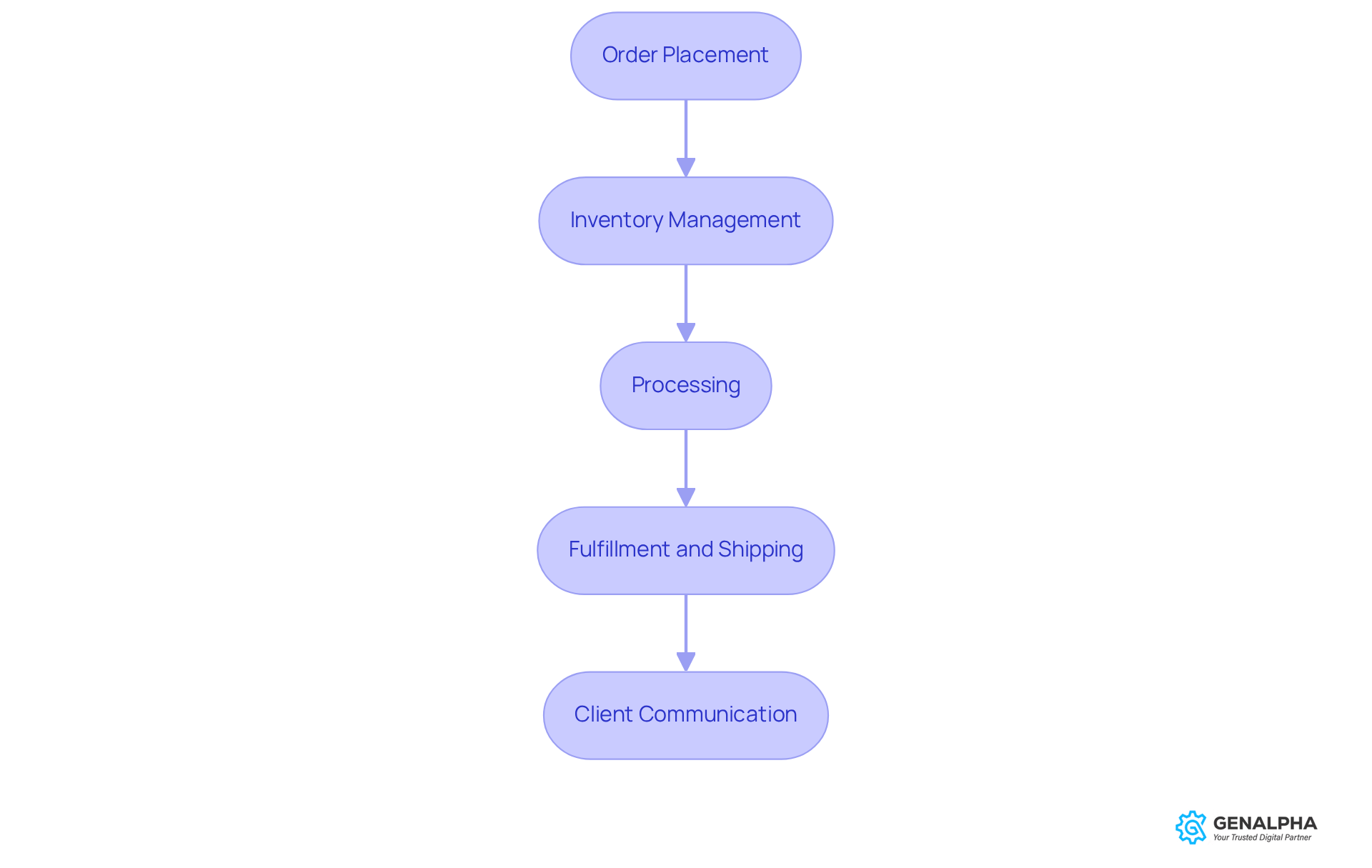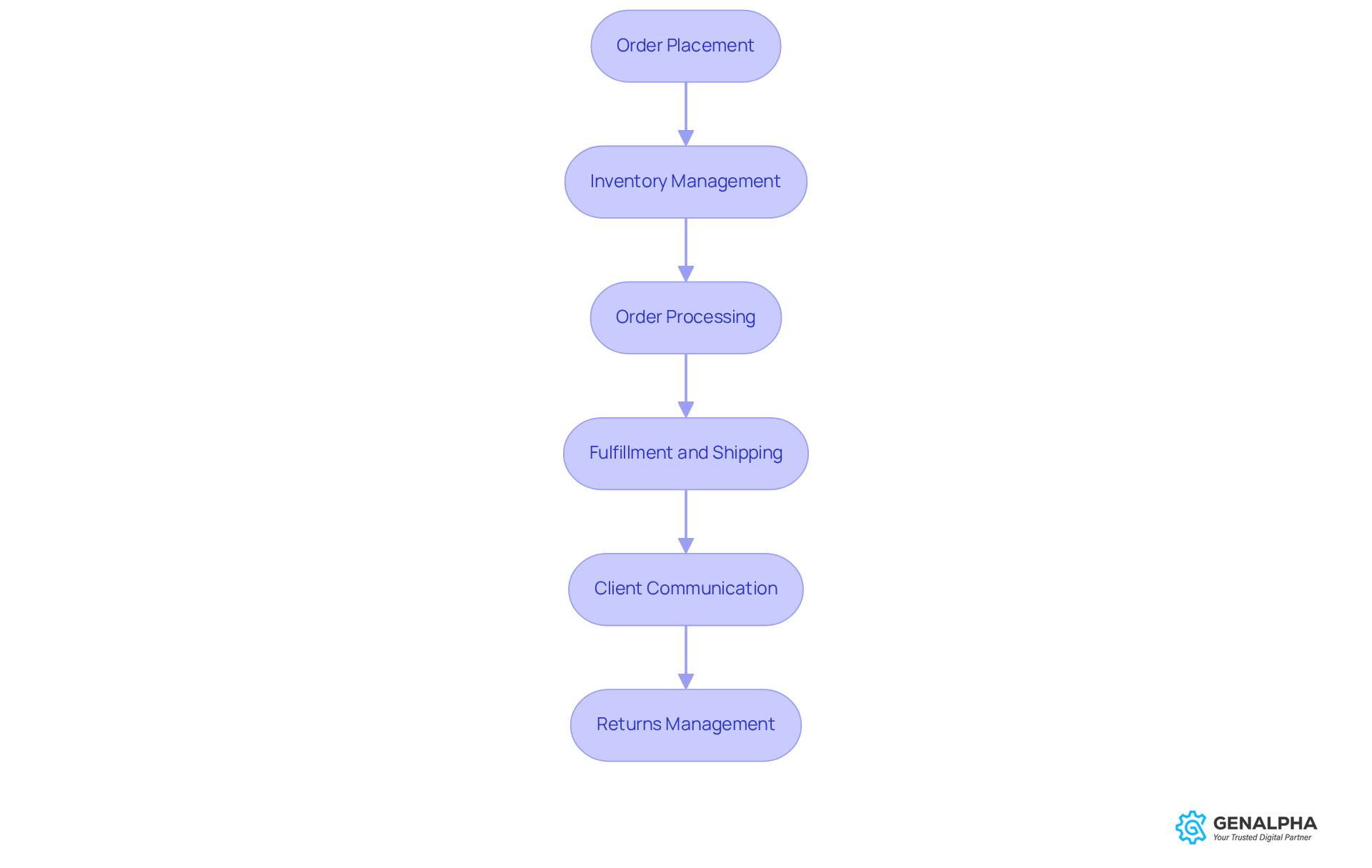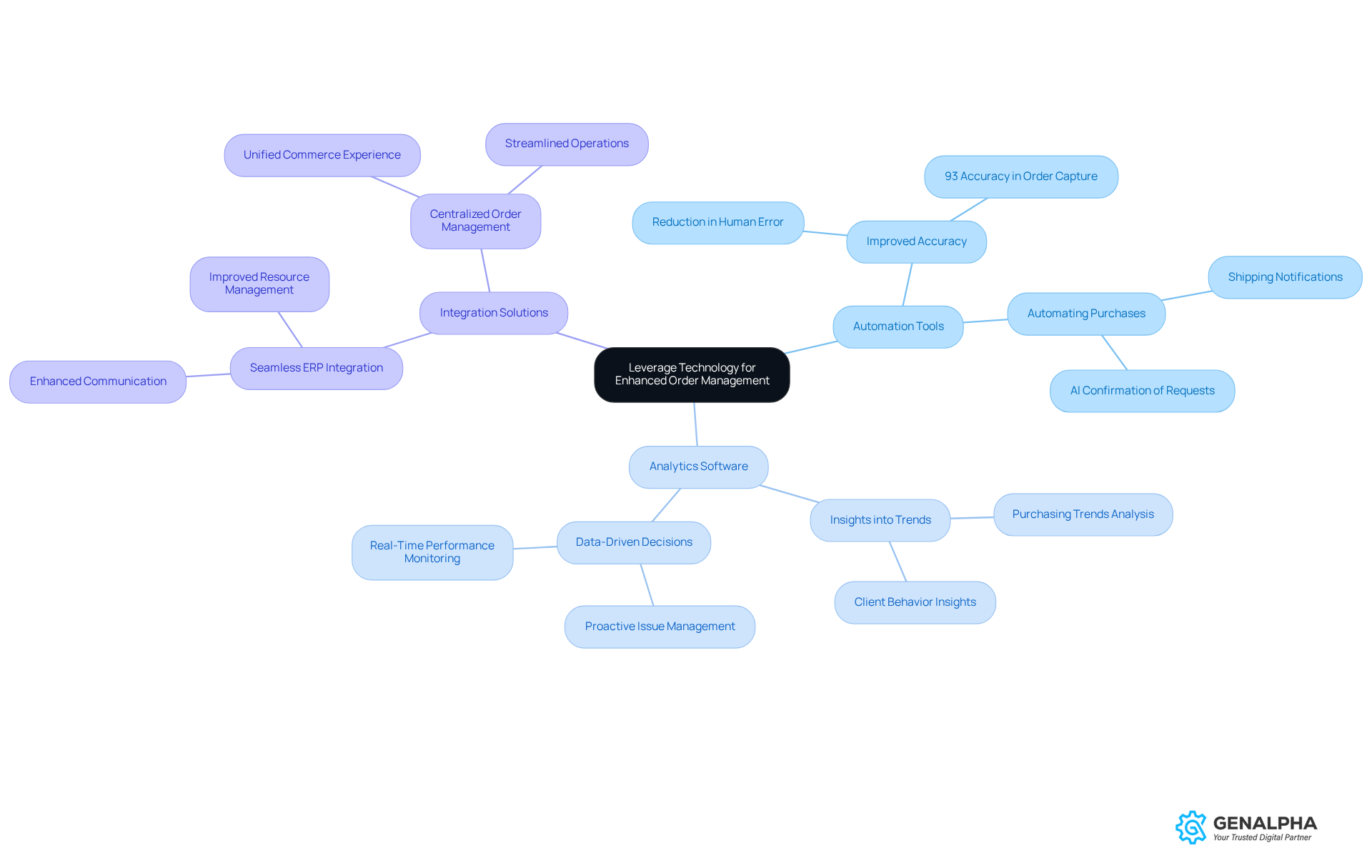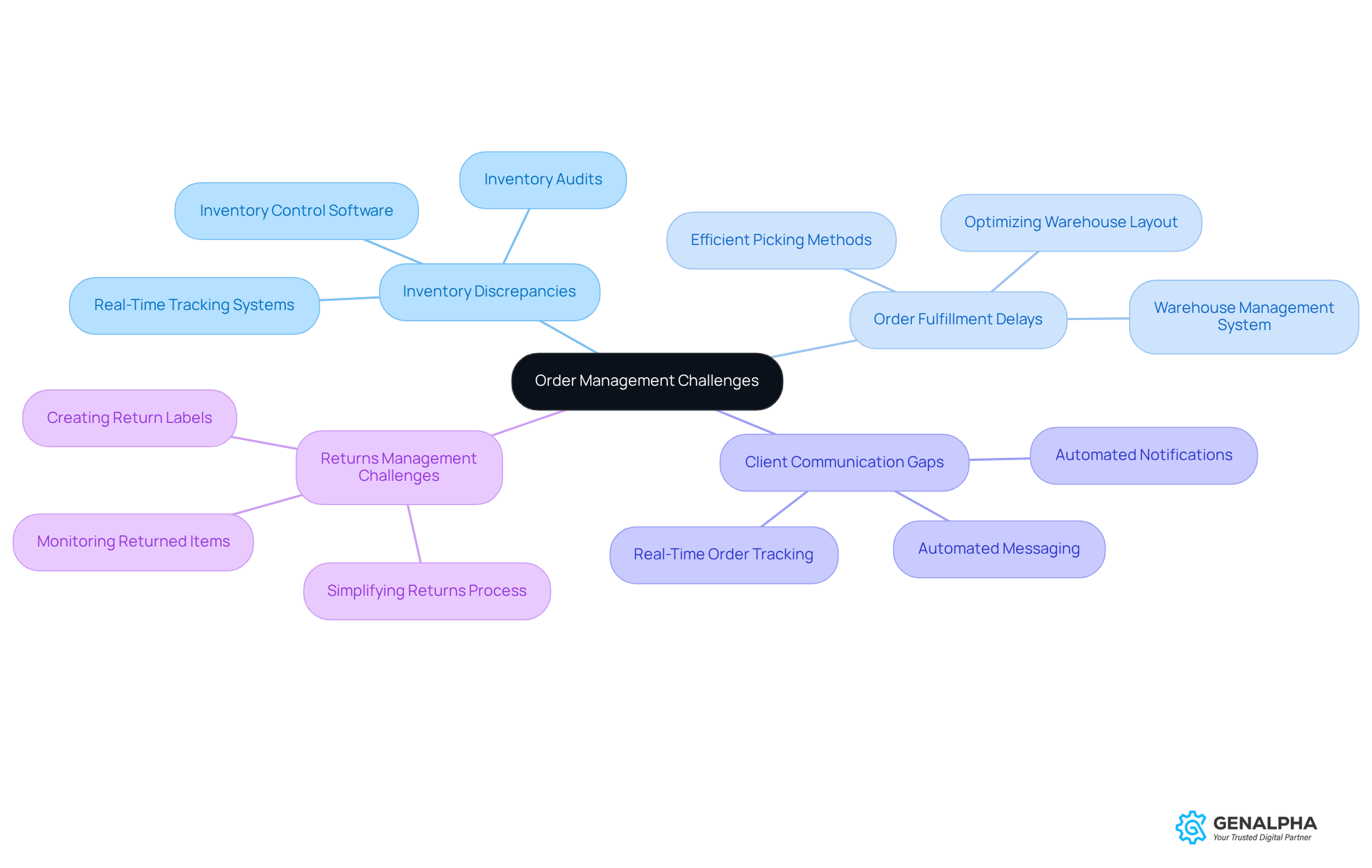Overview
This article dives into how we can optimize the eCommerce order management process with some straightforward steps and best practices.
Have you ever thought about how crucial effective order management is? It’s all about real-time inventory tracking, streamlined fulfillment, and clear communication with clients.
These elements are key to boosting operational efficiency and keeping customers happy, especially as eCommerce keeps growing and evolving.
So, let’s explore how we can make this happen together!
Introduction
Managing eCommerce orders effectively is more important than ever, especially with online shopping on the rise. Have you noticed how businesses that really get order management not only run things smoothly but also make their customers happier and more loyal? But with transaction volumes climbing and consumer expectations soaring, how can companies simplify their processes to keep up?
In this article, we’ll explore some essential steps and best practices for optimizing eCommerce order management. Get ready to turn challenges into exciting opportunities for growth!
Understand eCommerce Order Management Basics
Handling ecommerce order management is essential for ensuring that client requests go smoothly from start to finish, right up to delivery. Let’s break down the key components:
- Order Placement: This is where it all begins! Customers place their orders through various channels, which is not just important for revenue but also for keeping customers happy.
- Inventory Management: Keeping track of stock levels in real-time is crucial. It helps avoid those frustrating stockouts and overstock situations that can hurt your reputation and revenue.
- Processing: This phase is all about getting those orders ready for shipment. It involves picking, packing, and double-checking details to ensure everything is accurate and efficient.
- Fulfillment and Shipping: Getting products to clients on time is essential. Quick and precise fulfillment helps minimize delays and boosts customer satisfaction.
- Client Communication: Keeping clients in the loop about their order status is key to building trust and loyalty. Proactive updates and clear communication can really enhance the client experience.
Looking ahead to 2025, the need for strong system controls is more important than ever. As eCommerce continues to grow, companies need to enhance their ecommerce order management to keep up with increasing transaction volumes and customer expectations for fast, accurate, and clear fulfillment. We’ve seen that effective management strategies, like and teaming up with third-party logistics (3PL) providers, can really improve operations and support growth. 3PLs help manage the surge in requests while also cutting costs related to warehousing and shipping, making them vital partners in the eCommerce landscape.
Experts point out that without real-time inventory visibility, it can be tough to balance demand and supply across multiple locations. That’s why investing in an ecommerce order management system that consolidates requests from different channels into one easy-to-use dashboard is so important. It helps keep operations running smoothly and boosts customer satisfaction. As Jim Cahill puts it, "In the constantly changing realm of eCommerce, handling requests effectively has become more essential than ever.

Follow the Order Management Process Steps
To optimize your eCommerce order management, let’s explore some best practices together:
- Order Placement: Imagine a user-friendly website that makes placing an order a breeze. A seamless experience can really cut down on those pesky cart abandonment rates—did you know nearly 60% of consumers prefer companies that offer a variety of delivery options?
- Inventory Management: Think about implementing real-time inventory tracking. This will help you and overselling. Accurate inventory oversight is key; retailers often lose 10% to 20% of merchandise value on returns, which highlights the importance of precise stock levels. By using inventory management software, you can gain real-time insights into stock levels and automate reorder points, ensuring everything runs smoothly.
- Order Processing: Let’s streamline your picking and packing processes to keep delays at bay. Efficient ecommerce order management is essential for prompt fulfillment, and we all know how much client satisfaction and loyalty depend on it!
- Fulfillment and Shipping: Partnering with reliable shipping companies is crucial. Offering various shipping choices can meet different client expectations. Quick and flexible shipping is a must, especially since 53% of consumers consider delivery speed when making a purchase.
- Client Communication: How about automating updates to keep clients in the loop about their order status? This includes confirmations, shipping notifications, and delivery updates. Clear communication not only enhances the overall buyer experience but also builds trust. After all, 36% of shoppers have reported losing trust in an online marketplace due to challenges with returns or refunds.
- Returns Management: It’s important to create a straightforward and transparent return system. A hassle-free returns experience can boost buyer loyalty—did you know 96% of shoppers are more likely to repurchase if returns are easy?
By adopting these strategies, you can create a smooth system for ecommerce order management that not only improves operational efficiency but also enhances client satisfaction and loyalty. So, what will you implement first?

Leverage Technology for Enhanced Order Management
Using technology can really boost how you handle requests. Have you thought about these handy tools?
When you implement an (OMS), you’re centralizing ecommerce order management, inventory management, and customer communication. This not only streamlines operations but also enhances efficiency. Traditional systems often hit roadblocks that can stunt growth, which is why modern solutions are essential. Take Siemens Healthineers, for example; they revamped their management process, skyrocketing automated request rates from 8% to 85% and achieving a remarkable 93% accuracy in field capture.
- Automation Tools: Think about how much time you could save by automating repetitive tasks like confirming purchases, sending shipping notifications, and updating inventory. This speeds up processing times and cuts down on human error, leading to fewer mistakes and returns. AI systems, for instance, can confirm requests automatically, boosting overall accuracy and client satisfaction. Andrea Zoppi, CFO of Siemens Healthineers, put it perfectly: "Esker Synergy AI has not only automated our management process but has also improved the abilities of our Service team by simplifying their focus on client needs and experience."
- Analytics Software: By utilizing analytics, you gain insights into purchasing trends, client behavior, and inventory performance, which helps in making data-driven decisions. Companies that tap into real-time insights can tackle issues before they blow up, ensuring operations run smoothly.
- Integration Solutions: It’s crucial to ensure your eCommerce platform integrates seamlessly with your ERP and other systems. This integration enhances ecommerce order management by improving monitoring and communication, which are vital for effectively managing resources.
By embracing these technologies, businesses can sharpen precision, shorten processing times, and elevate the overall client experience, setting themselves up for success in a competitive marketplace. So, what are you waiting for? Let’s get started on this tech journey together!

Identify and Overcome Order Management Challenges
Managing ecommerce order management can be a bit of a headache, can't it? Let’s dive into some common challenges that might be slowing you down and keeping your customers from being completely satisfied.
- Inventory Discrepancies: Ever had a customer order something only to find out it’s out of stock? To avoid this, make it a habit to conduct regular inventory audits and consider implementing real-time tracking systems. By incorporating inventory control software into your ecommerce order management system, you can enhance accuracy and ensure that only available products are displayed to customers. This way, you’ll reduce the chances of .
- Order Fulfillment Delays: Nobody likes waiting for their orders, right? Streamlining your fulfillment process can make a world of difference. Think about optimizing your warehouse layout and using efficient picking methods. A warehouse management system is essential for ecommerce order management as it can significantly cut down on average fulfillment delays, which is crucial as eCommerce continues to grow in 2025.
- Client Communication Gaps: Keeping your clients in the loop is key. Automating your messaging can help keep customers informed at every step of their purchase. By adding real-time order tracking and automated notifications, you’ll not only improve their experience but also build trust. After all, timely updates can really ease the frustration during delays.
- Returns Management Challenges: Returns can be tricky, but they don’t have to be! Simplifying your returns process by creating return labels and automatically monitoring returned items can enhance client satisfaction. This approach reduces friction in the buying experience and encourages repeat business.
So, how do we tackle these challenges effectively? Regularly reviewing your processes, gathering customer feedback, and adapting your strategies are essential steps. By implementing smart measures to overcome these ecommerce order management hurdles, you’ll keep your system running smoothly and meet the ever-evolving demands of the eCommerce world.

Conclusion
Effective eCommerce order management is a key player in achieving success in the digital marketplace. Think about it: from order placement to client communication, understanding these essential components can help businesses create a seamless experience that not only meets but truly exceeds customer expectations. As the eCommerce landscape keeps evolving, optimizing these processes becomes even more crucial for staying ahead of the competition.
So, what are some strategies to enhance order management? The article pointed out several, like:
- Real-time inventory tracking
- Efficient order processing
- Strong client communication
It’s all about leveraging technology! Tools such as automation, analytics, and integration solutions can really streamline operations and boost accuracy. Plus, tackling common challenges like inventory discrepancies and fulfillment delays is vital for building customer loyalty and satisfaction.
Ultimately, the journey toward optimized eCommerce order management isn’t just about rolling out new systems. It’s about embracing a customer-centric approach that puts efficiency and transparency front and center. By taking actionable steps today, we can all position ourselves for success in this ever-growing eCommerce environment. After all, it’s not just about meeting the demands of our clientele; it’s about paving the way for future growth together.
Frequently Asked Questions
What is the importance of eCommerce order management?
eCommerce order management is essential for ensuring that client requests are handled smoothly from order placement to delivery, which is crucial for customer satisfaction and revenue.
What are the key components of eCommerce order management?
The key components include order placement, inventory management, processing, fulfillment and shipping, and client communication.
How does order placement impact eCommerce?
Order placement is the starting point for the entire process, and it is important for generating revenue and keeping customers happy.
Why is inventory management crucial in eCommerce?
Real-time inventory management helps avoid stockouts and overstock situations, which can negatively affect a company's reputation and revenue.
What does the processing phase involve?
The processing phase involves preparing orders for shipment, which includes picking, packing, and double-checking details to ensure accuracy and efficiency.
What role does fulfillment and shipping play in eCommerce?
Fulfillment and shipping are critical for delivering products to clients on time, minimizing delays, and boosting customer satisfaction.
How important is client communication during the order management process?
Client communication is key to building trust and loyalty, as proactive updates and clear communication enhance the client experience.
What trends are expected in eCommerce order management by 2025?
By 2025, strong system controls will be increasingly important due to growing transaction volumes and customer expectations for fast, accurate fulfillment.
How can companies improve their eCommerce order management strategies?
Companies can improve their strategies by automating workflows and partnering with third-party logistics (3PL) providers to manage requests and reduce costs.
Why is real-time inventory visibility important?
Real-time inventory visibility is crucial for balancing demand and supply across multiple locations, helping to maintain smooth operations and customer satisfaction.
What is the benefit of an eCommerce order management system?
An eCommerce order management system consolidates requests from various channels into a single dashboard, facilitating smoother operations and enhancing customer satisfaction.




